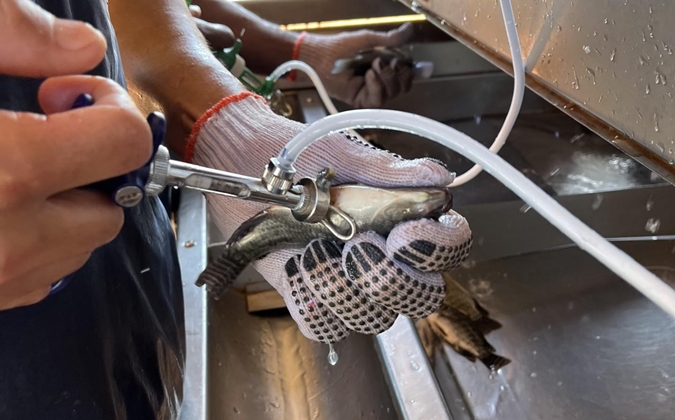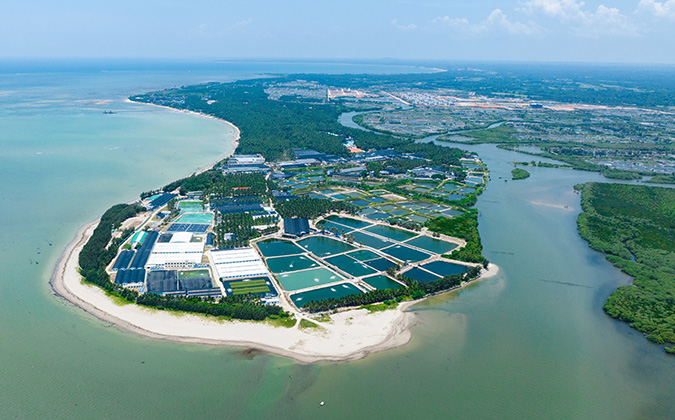
Fish Farm Forum is pleased to host this editorial page on behalf of Pharmaq.
Pharmaq
Temperature and timing key to effective vaccination using ALPHA JECT LiVac® SRS
Temperature in the first days after vaccination is critical in ensuring that a live attenuated vaccine is effective against salmonid rickettsial septicemia (SRS), one of the main disease challenges in Chilean salmon aquaculture.
PHARMAQ’s commercial vaccine ALPHA JECT LiVac® SRS has been widely used on Chilean salmon farms since its introduction in 2016, contributing to a reduction in the use of antibiotics, which is the primary treatment method for the disease in Chile.
Scientists tested the product in four vaccination and challenge trials in Norway as part of a raft of studies exploring different performance aspects relevant to field usage.1
Testing temperature impact
In one of the trials, they sought to examine efficacy of the product 15 months after application, in a model that included a 60-day simulated winter period at 8° C prior to challenge for some of the fish.
Another trial was a test of vaccine efficacy when fish were immunized at 8° C, 10° C or 12° C. The third again tested vaccination at multiple temperatures (7° C, 8° C, 10° C, 11° C and 15° C) but with the group vaccinated at 15° C kept at that temperature for 5 days before the researchers reduced the temperature by two degrees each day down to 7° C. This trial also involved the scientists sampling six fish per vaccinated group at 1, 2, 5, 7 and 14 days post-vaccination to assess levels of vaccine-strain RNA in the animals’ livers.
Scientists conducted a fourth trial without a challenge to generate cycle threshold values, which show the concentration of bacterial material. They vaccinated fish used in the study at higher temperatures (12° C and 17° C).
A 10° C ‘tipping point’
From the data collected over the four experiments, they found that maintaining a high temperature for the first 5 days after vaccination was critical in ensuring the product’s optimum efficacy against the bacterium which causes the disease, Piscirickettsia salmonis.
Fish vaccinated at 10° C and above were well protected, with a significant loss of protection for those vaccinated at 7° C and 8° C. The team also detected no growth of the vaccine-strain bacteria in fish livers at 8° C.
“There is a very clear cutoff at 10 degrees or lower — then, performance drops dramatically,” said Rolf Hetlelid Olsen, principal scientist for PHARMAQ, who led the study.
“The findings are very similar to the performance of the bacteria when you culture it,” he continued. “It’s very natural to see that you have this temperature effect, because when you try to cultivate the bacteria, you get almost zero growth at the lowest temperatures we used in the studies and gradually better growth the higher temperature you have. This correlates very well with the protection we saw.”
Live vaccines and cold-blooded animals
Overall, the findings neatly reflect the reality of vaccinating cold-blooded animals, says Marius Karlsen, PhD, senior technical manager, outcomes research for PHARMAQ.
“When mammals receive a live vaccine, it generally will have the same effects all the time, but in a cold-blooded animal, you need to really hit a temperature that is optimal for the vaccine strain to get the benefit from it, given it is alive and not an inactivated pathogen,” Karlsen explained.
“If you vaccinate at too low temperature, where it can’t replicate, then the effects will probably be quite similar as an inactivated antigen and just be there but not do anything. It doesn’t activate the part of the immune system that you would like.”
Studies provide clarity
Rigorous laboratory models are essential to determine vaccine performance under various conditions, Olsen said, as fish production companies do not allow much of their field data to be scrutinized. In the field, ALPHA JECT LiVac SRS is also often used in combination with a multivalent vaccine which has a P. salmonis component, meaning it is hard to isolate the effects of each product.
Some commercial vaccines have had limited success in tackling SRS on Chilean salmon farms, Karlsen added, which is likely because P. salmonis is an intracellular pathogen against which regular inactivated vaccines can struggle to make an impact. Continued testing of the live attenuated product ensures that performance can be optimized.
“When talking to customers, generally the feedback is that they are quite happy with the vaccine,” he said. “But obviously SRS is still a problem in Chile, so all of them would like something that could reduce the problem even more. I think anything we can do to improve the effect of this vaccine would be beneficial.”
Guiding best practice
Although the advice to producers has always been to not use the vaccine below 10° C, the findings have served to further underline the rationale. A number of producers using the vaccine have the ability to choose temperatures in their systems, Olsen explained, often electing to vaccinate close to transportation to make it more economical to heat the water for the necessary period. Saving energy in the critical period may not be the best economical solution in the long run.
In the short-to-medium term, there is little prospect of a more effective technology than a live vaccine as a preventative measure against SRS, Karlsen said, meaning that the focus should be on optimizing use of what is currently available.
“From my perspective, working in the development of new vaccines, there’s a lot of talk and buzzwords about new technologies, but when you look at the vaccines that actually perform, both in humans and in animals, it’s often going back to the oldest technology, which is a live vaccine. It’s very difficult to replace the richness of immune response that a live vaccine creates,” he added.
1 Olsen RH, Finne-Fridell F, Bordevik M, Nygaard A, Rajan B, Karlsen M. The effect of an attenuated live vaccine against salmonid rickettsial septicemia in Atlantic salmon (Salmo salar) is highly dependent on water temperature during immunization. Vaccines. 2024;12(4):416.
Posted on: December 09, 2024







